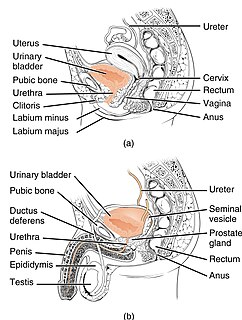Related Research Articles

Orgasm is the sudden discharge of accumulated sexual excitement during the sexual response cycle, resulting in rhythmic muscular contractions in the pelvic region characterized by sexual pleasure. Experienced by males and females, orgasms are controlled by the involuntary or autonomic nervous system. They are usually associated with involuntary actions, including muscular spasms in multiple areas of the body, a general euphoric sensation and, frequently, body movements and vocalizations. The period after orgasm is typically a relaxing experience, attributed to the release of the neurohormones oxytocin and prolactin as well as endorphins.

In female human anatomy, Skene's glands or the Skene glands are glands located around the lower end of the urethra. The glands are surrounded by tissue that swells with blood during sexual arousal, and secrete a fluid from openings near the urethra, particularly during orgasm.

The G-spot, also called the Gräfenberg spot, is characterized as an erogenous area of the vagina that, when stimulated, may lead to strong sexual arousal, powerful orgasms and potential female ejaculation. It is typically reported to be located 5–8 cm (2–3 in) up the front (anterior) vaginal wall between the vaginal opening and the urethra and is a sensitive area that may be part of the female prostate.

Female ejaculation is characterized as an expulsion of fluid from the Skene's gland at the lower end of the urethra during or before an orgasm. It is also known colloquially as squirting, although research indicates that female ejaculation and squirting are different phenomena, squirting being attributed to a sudden expulsion of liquid that partly comes from the bladder and contains urine.

Urinary incontinence (UI), also known as involuntary urination, is any uncontrolled leakage of urine. It is a common and distressing problem, which may have a large impact on quality of life. It has been identified as an important issue in geriatric health care. The term enuresis is often used to refer to urinary incontinence primarily in children, such as nocturnal enuresis. UI is an example of a stigmatized medical condition, which creates barriers to successful management and makes the problem worse. People may be too embarrassed to seek medical help, and attempt to self-manage the symptom in secrecy from others.

Vaginismus is a condition in which involuntary muscle spasm interferes with vaginal intercourse or other penetration of the vagina. This often results in pain with attempts at sex. Often, it begins when vaginal intercourse is first attempted.
Premature ejaculation (PE) occurs when a man expels semen soon after beginning sexual activity, and with minimal penile stimulation. It has also been called early ejaculation, rapid ejaculation, rapid climax, premature climax and (historically) ejaculatio praecox. There is no uniform cut-off defining "premature", but a consensus of experts at the International Society for Sexual Medicine endorsed a definition of around one minute after penetration. The International Classification of Diseases (ICD-10) applies a cut-off of 15 seconds from the beginning of sexual intercourse.
Dyspareunia is painful sexual intercourse due to medical or psychological causes. The term dyspareunia covers both female dyspareunia and male dyspareunia, but many discussions that use the term without further specification concern the female type, which is more common than the male type. In females, the pain can primarily be on the external surface of the genitalia, or deeper in the pelvis upon deep pressure against the cervix. Medically, dyspareunia is a pelvic floor dysfunction and is frequently underdiagnosed. It can affect a small portion of the vulva or vagina or be felt all over the surface. Understanding the duration, location, and nature of the pain is important in identifying the causes of the pain.
Sexual stimulation is any stimulus that leads to, enhances and maintains sexual arousal, and may lead to orgasm. Although sexual arousal may arise without physical stimulation, achieving orgasm usually requires physical sexual stimulation.
Persistent genital arousal disorder (PGAD), previously called persistent sexual arousal syndrome, is spontaneous, persistent, unwanted and uncontrollable genital arousal in the absence of sexual stimulation or sexual desire, and is typically not relieved by orgasm. Instead, multiple orgasms over hours or days may be required for relief.

Kegel exercise, also known as pelvic-floor exercise, involves repeatedly contracting and relaxing the muscles that form part of the pelvic floor, now sometimes colloquially referred to as the "Kegel muscles". The exercise can be performed many times a day, for several minutes at a time but takes one to three months to begin to have an effect.
Sexual dysfunction is difficulty experienced by an individual or partners during any stage of normal sexual activity, including physical pleasure, desire, preference, arousal, or orgasm. The World Health Organization defines sexual dysfunction as a "person's inability to participate in a sexual relationship as they would wish". This definition is broad and is subject to many interpretations. A diagnosis of sexual dysfunction under the DSM-5 requires a person to feel extreme distress and interpersonal strain for a minimum of six months. Sexual dysfunction can have a profound impact on an individual's perceived quality of sexual life. The term sexual disorder may not only refer to physical sexual dysfunction, but to paraphilias as well; this is sometimes termed disorder of sexual preference.
Sexual medicine is a branch of medicine concerning the diagnosis, treatment, and prevention of disorders of sexual function. Examples of disorders treated with sexual medicine are erectile dysfunction, hypogonadism, and prostate cancer. Sexual medicine often uses a multidisciplinary approach involving physicians, mental health professionals, social workers, and sex therapists. Sexual medicine physicians often approach treatment with medicine and surgery, while sex therapists often focus on behavioral treatments.
Intravaginal ejaculation latency time (IELT) is the time it takes to ejaculate during vaginal penetration. Average IELT varies between people and tends to decrease with age.

Ejaculation is the discharge of semen from the male reproductory tract as a result of an orgasm. It is the final stage and natural objective of male sexual stimulation, and an essential component of natural conception. In rare cases, ejaculation occurs because of prostatic disease. Ejaculation may also occur spontaneously during sleep. Anejaculation is the condition of being unable to ejaculate. Ejaculation is usually very pleasurable for men; dysejaculation is an ejaculation that is painful or uncomfortable. Retrograde ejaculation is the condition where semen travels backwards into the bladder rather than out the urethra.
Postorgasmic illness syndrome is a syndrome in which people have chronic physical and cognitive symptoms immediately following ejaculation. The symptoms last for up to a week. The cause and prevalence are unknown; it is considered a rare disease.
Sexual anhedonia, also known as pleasure dissociative orgasmic disorder, is a condition in which an individual cannot feel pleasure from an orgasm. It is thought to be a variant of hypoactive sexual desire disorder.
Ejaculation disorders are the most common sexual dysfunction in men. Common ejaculatory disorders include: premature ejaculation, retrograde ejaculation, delayed ejaculation, anejaculation, inhibited ejaculation, and anorgasmia.
Dysorgasmia is the experience of pain after an orgasm, usually in the abdomen. The condition may be experienced during or after orgasm, sometimes as late as several hours after the orgasm occurred. Both men and women can experience orgasmic pain. The term is sometimes used interchangeably with painful ejaculation when experienced by a man, but ejaculatory pain is only a subtype of male dysorgasmia as men can experience pain without ejaculating. The phenomenon is poorly understood and underresearched. Dysorgasmia can come as a side effect of surgical interventions such as prostatectomy.
Pelvic floor physical therapy (PFPT) is a specialty area within physical therapy focusing on the rehabilitation of muscles in the pelvic floor after injury or dysfunction. It can be used to address issues such as muscle weakness or tightness post childbirth, dyspareunia, vaginismus, vulvodynia, constipation, fecal or urinary incontinence, pelvic organ prolapse, and sexual dysfunction. Licensed physical therapists with specialized pelvic floor physical therapy training address dysfunction in individuals across the gender and sex spectra, though PFPT often associated with women's health for its heavy focus on addressing issues of pelvic trauma after childbirth.
References
- ↑ Serati, Maurizio; Salvatore, Stefano; Uccella, Stefano; Nappi, Rossella E.; Bolis, Pierfrancesco (January 2009). "Female Urinary Incontinence During Intercourse: A Review on an Understudied Problem for Women's Sexuality". The Journal of Sexual Medicine. 6 (1): 40–48. doi:10.1111/j.1743-6109.2008.01055.x. PMID 19170835.
- 1 2 Pastor, Zlatko (July 2013). "Female ejaculation orgasm vs. coital incontinence: a systematic review". The Journal of Sexual Medicine. 10 (7): 1682–1691. doi:10.1111/jsm.12166. ISSN 1743-6109. PMID 23634659.
- ↑ Constantini, Elisabetta (April 2018). "Coital Urinary Incontinence". International Continence Society. Retrieved 2019-06-06.